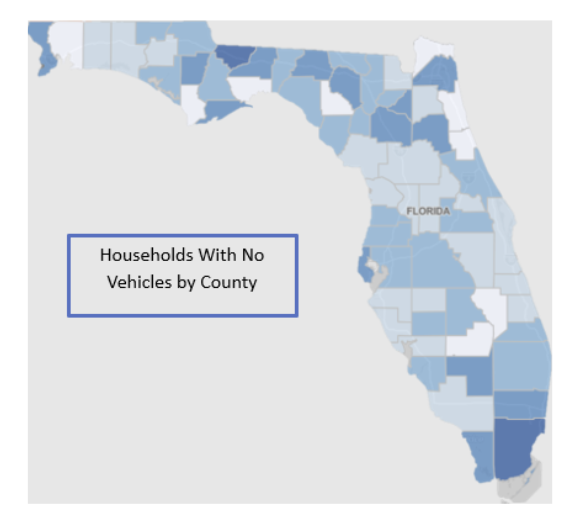As we focus on ensuring high-quality job opportunities are available in every community throughout Florida, it is more important than ever that we continue to highlight and support successful job training programs that can lead to highly valued career pathways.
When we analyze access to transportation and its impacts on childhood poverty, one metric we consider is access to vehicles within the household. Having access to a vehicle not only helps individuals get to and from work, but it also has a major impact on access to educational programs/opportunities, food resources, housing, health facilities, and more.

Above is a heat map displaying the latest information on the percentage of households with no vehicles, broken down by county. Throughout Florida, 6% of occupied households do not have a vehicle. However, this challenge can be exacerbated at the county and local level, impacting community prosperity.
Take Gadsden County, a rural county just northeast of Tallahassee that borders Georgia. Throughout the county, 9.4% of households do not have access to a vehicle. However, when we look at this information at the zip code level, we find that in 32351 (Quincy, Florida), 16.4% of households do not have a vehicle. Additionally, with 32351 being a rural community, there is minimal access to public transportation – in fact, only 0.3% of workers within 32351 use public transportation to get to work.[1]
What impact does this have? 32351 is also one of Florida’s most impoverished zip codes. Currently, 2,198 children within 32351 (54.9%) live in poverty. These figures have increased compared to 2020 and may be an indicator that the lack of access to transportation has isolated this community from potential opportunities.
Improving access to transportation within communities of need can have a dramatic impact in opening doors to underutilized opportunities. By reviewing transportation access at the zip code level, a feature available on the Florida Chamber Foundation’s Florida Gap Map, businesses and policy leaders can make targeted investments in transportation infrastructure in communities with minimal transportation assets or affordable housing investments in communities with sufficient public transportation assets. This ultimately will help improve the path to prosperity in neighborhoods across Florida.
[1] U.S. Census BureauTo get involved with our Florida Equality of Opportunity Initiative’s Florida Prosperity Project’s efforts to prioritize transportation or any of the other root causes of poverty on the path to prosperity, contact Zenani Johnson at zjohnson@flchamber.com or 850-521-1291.